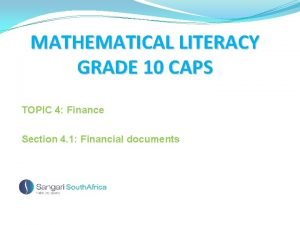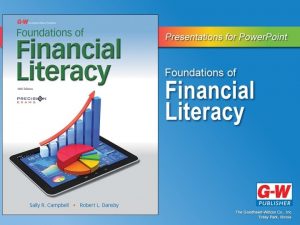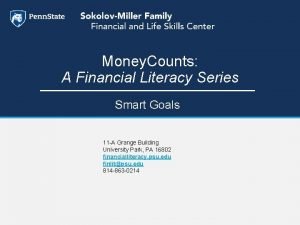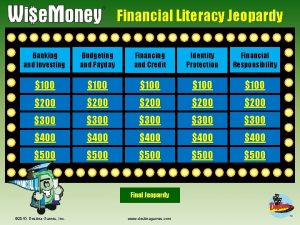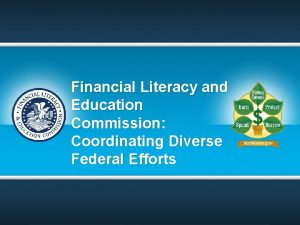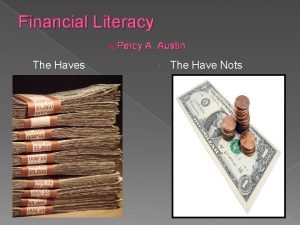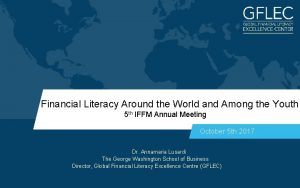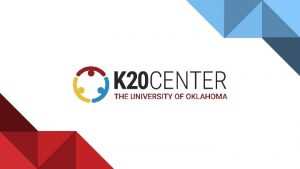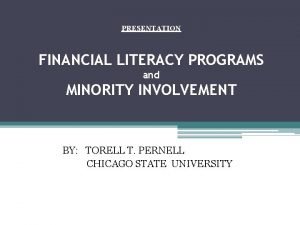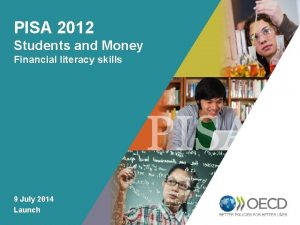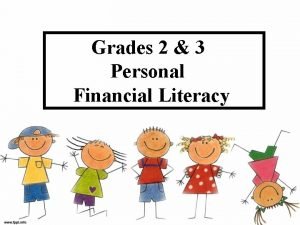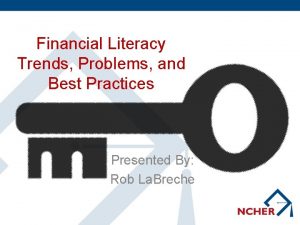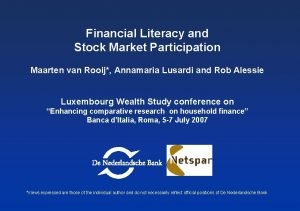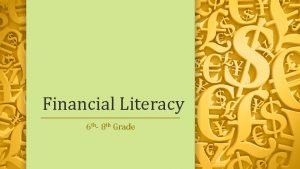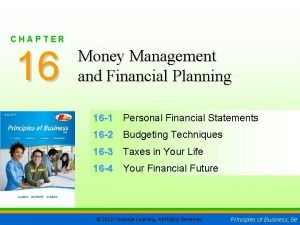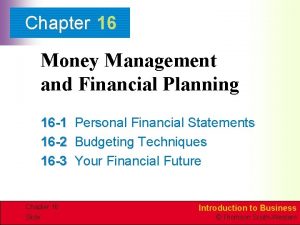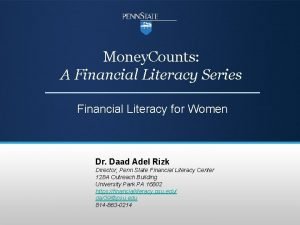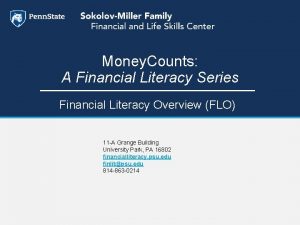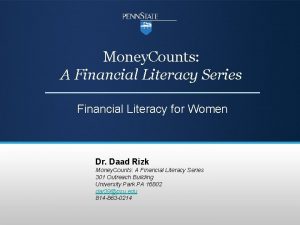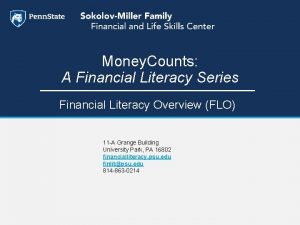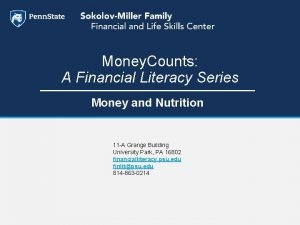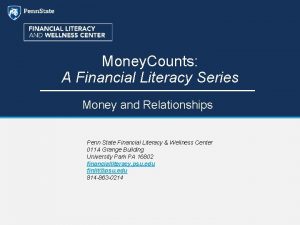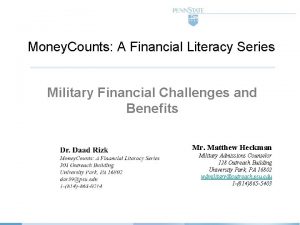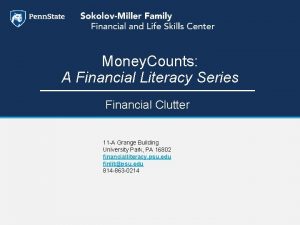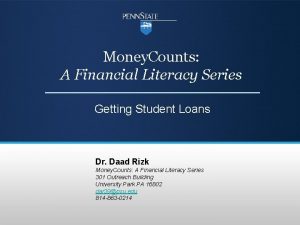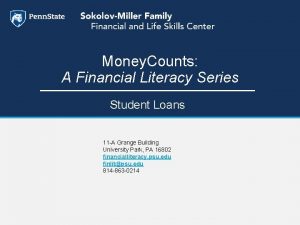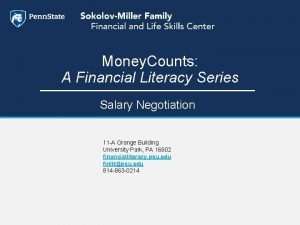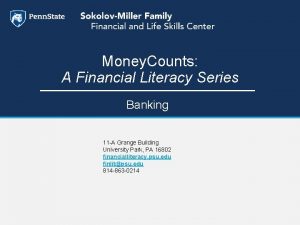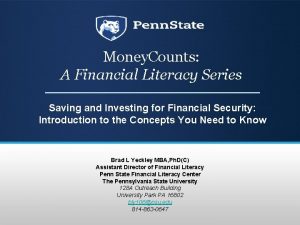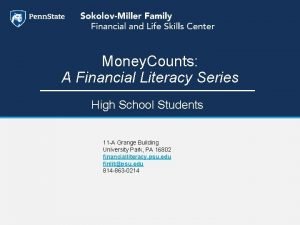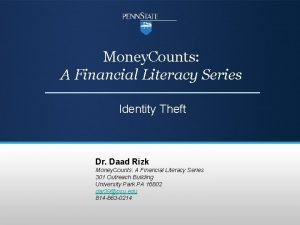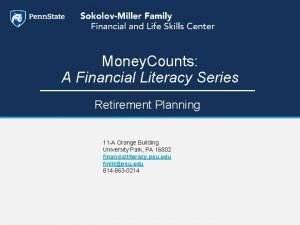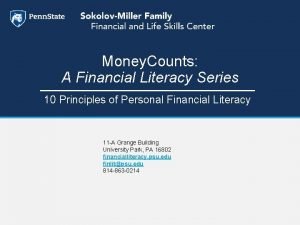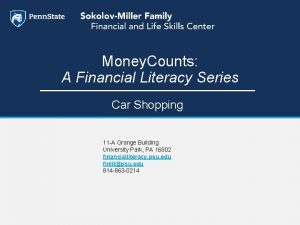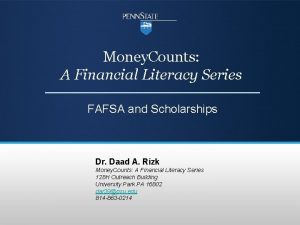Money Counts A Financial Literacy Series Using Student
































- Slides: 32

Money. Counts: A Financial Literacy Series Using Student Loans Responsibly Brad L Yeckley, MBA PHD(c) Assistant Manager of Financial Literacy Penn State Financial Literacy Center 128 Outreach Building University Park PA 16802 bly 106@psu. edu 814 -863 -6470

Student Loans A Crisis of Personal Responsibility Money. Counts: A Financial Literacy Series

Voices of Debt - Student Loan Crisis • • • Jot down any ideas or items that catch your attention Consider micro and macro economic impact What are your responsibilities What could / should be done Who's fault is it? How do you feel about it Money. Counts: A Financial Literacy Series

What can you do? • Take on an investment mindset • Know what you are borrowing • Be involved in the process • Use only what is necessary • Have a plan • Take responsibility • Graduate Money. Counts: A Financial Literacy Series

10 Steps for managing your student loan debt Money. Counts: A Financial Literacy Series

1: Consider student loans only after you have researched all the sources of free financial aid (including scholarships, grants and work-study). Money. Counts: A Financial Literacy Series

• • • AMERICAN ASSOCIATION OF CANDY TECHNOLOGISTS AACT'S JOHN KITT MEMORIAL SCHOLARSHIP 2015 -2016 AACT is proud to announce its John Kitt Memorial Scholarship for the 2015 -2016 academic year. The scholarship award for the recipient is $5, 000. 00, paid in two $2, 500. 00 installments after verification of enrollment. • To qualify for this non-renewing scholarship award, the student must meet the following criteria: • • College sophomore, Junior or Senior status (in 2014 -2015). • Have a demonstrated interest in confectionery technology. • Attend an accredited, four-year college or university within North America. • Be majoring in a food science, chemical science, biological science, or related area. • Achieved a 3. 0 (out of 4. 0) GPA (or equivalent on another scale). Your demonstrated interest in confectionery technology can include many activities including but not limited to research projects, work experience, and formal study. Money. Counts: A Financial Literacy Series

American Fire Sprinkler Association Scholarship Program This online scholarship is unlike many traditional scholarship essay contests. That’s because instead of writing an essay, applicants will read one. That’s right! To apply, students must go online and read a short essay about sprinklers and fire safety. After finishing, they complete a 10 -question quiz on what they just read. Each correct answer gives the student a chance at winning one of 10 $2, 000 scholarships (maximum 10 chances per entrant). You literally can’t go wrong with this scholarship! The American Fire Sprinkler Association (AFSA) Scholarship Contest is open to high school seniors in the United States who plan to further their education at a college/university or certified trade school in the United States. Home-schooled students may apply as long as your course of study is equivalent to that of a senior in high school. The scholarship is not based on financial need. Money. Counts: A Financial Literacy Series

Tall Clubs International Student Scholarships Are you under 21 years of age and about to start college in the fall? If so, you may be in luck! TCI annually awards student scholarship(s) of up to $1, 000 each to tall students who are under 21 years of age and attending their first year of college in the following fall. What are the requirements? - You must be under 21. - You must be entering college in the upcoming fall. - You must also meet the TCI height requirement minimums: 5’ 10? for women and 6’ 2? for men. - You must find a local Tall Club member to sponsor you. If you are interested in applying for a TCI Scholarship Award, you must contact a TCI Member Club closest to you for sponsorship. Even if they don’t have a local Student Scholarship, they may simply appoint you as their candidate. Once you have a local sponsor, your name will be submitted to the TCI Foundation. Should the Foundation select you as an award winner, you will be notified by your local sponsoring TCI club and presented with the award. Money. Counts: A Financial Literacy Series

• http: //www. fastweb. com/ • https: //bigfuture. collegeboard. org/ scholarship-search Money. Counts: A Financial Literacy Series

2: Consider all the loan programs available, and compare all your options before making a final decision. Only consider alternative/private loans as a last resort. Money. Counts: A Financial Literacy Series

• • When possible, always use federal loan dollars first. Utilize subsidized funds, if available. (need based) Federal Parent Plus and Perkins loans are also an option Use private loans as a last resort Money. Counts: A Financial Literacy Series

3: Plan an in-school and after-school budget before you take out your first student loan. Stick to it. Money. Counts: A Financial Literacy Series

• Budget Basics – – – – Make a list of your values Set goals Determine income Determine expenses Create your budget Pay yourself first Evaluate periodically Money. Counts: A Financial Literacy Series

4: Determine how much you can afford to borrow and how much you can realistically repay. Money. Counts: A Financial Literacy Series

• http: //www. finaid. org/calculators/loanpayments. phtml • This Loan Payment Calculator computes an estimate of the size of your monthly loan payments and the annual salary required to manage them without too much financial difficulty. Money. Counts: A Financial Literacy Series

Loan Balance: Adjusted Loan Balance: Loan Interest Rate: Loan Fees: Loan Term: Minimum Payment: Enrollment Status: Degree Program: Total Years in College: Average Debt per Year: Monthly Loan Payment: Number of Payments: Cumulative Payments: Total Interest Paid: $40, 000. 00 $40, 816. 33 6. 80% 2. 00% 10 years $50. 00 In Repayment Bachelor's Degree 4 years $10, 000. 00 $469. 72 120 $56, 365. 65 $16, 365. 65 Money. Counts: A Financial Literacy Series

• It is estimated that you will need an annual salary of at least $56, 366. 40 to be able to afford to repay this loan. This estimate assumes that 10% of your gross monthly income will be devoted to repaying your student loans. This corresponds to a debt-to-income ratio of 0. 7. If you use 15% of your gross monthly income to repay the loan, you will need an annual salary of only $37, 577. 60, but you may experience some financial difficulty. This corresponds to a debt-to-income ratio of 1. Money. Counts: A Financial Literacy Series

• The average starting salary to graduates in the humanities and social sciences increased 2. 8 percent over last year, bringing it to $36, 237. The overall average salary for engineering graduates, meanwhile, rose 2. 6 percent to $63, 062. • What do these numbers tell you about your responsibilities and choices with regard to funding your education? Money. Counts: A Financial Literacy Series

5: Know your federal aid eligibility status so that you are not forced to use private loans. Money. Counts: A Financial Literacy Series

• Satisfactory Academic Progress Standards • Aggregate Limit • Credit load Money. Counts: A Financial Literacy Series

• SAP – Max Timeframe – Completion rate • Credit Load – 6 – 5 Money. Counts: A Financial Literacy Series

• Aggregate Loan Limits Dependent Undergraduate Student Dependent Undergraduate Independent Undergraduate Graduate and Professional Student with a Parent PLUS Student Degree Student Loan denial* First-Year (0 – 27 credits) $5, 500 $9, 500 A maximum of $3, 500 may be $20, 500 subsidized Second-Year (27. 1 – 59 credits) $6, 500 $10, 500 A maximum of $4, 500 may be $20, 500 subsidized Third-, Fourth-, and Fifth. Years (59. 1+ credits) $7, 500 $12, 500 A maximum of $5, 500 may be $20, 500 subsidized Career Maximum Loan Amounts $31, 000 A maximum of $23, 000 may be subsidized $57, 500 A maximum of $23, 000 may be subsidized Money. Counts: A Financial Literacy Series $138, 500 The graduate debt limit includes Stafford loans received for undergraduate study.

6: Work while you are in school. Pay interest on unsubsidized loans if possible. Money. Counts: A Financial Literacy Series

• Avoid Negative Amortization • Deferring the interest during the in-school and grace period increases the loan balance at repayment by about 18. 5% and the total payments over the life of a 10 -year loan by 8. 8% of the amount originally borrowed. On a 20 -year term the total payments increase by 17. 2% of the amount originally borrowed and on a 30 -year term the total payments increase by 26. 7% of the amount originally borrowed. Money. Counts: A Financial Literacy Series

7: Consider deferments, forbearance or a change in repayment plans to fit your situation. Understand what each one means Money. Counts: A Financial Literacy Series

• A deferment is a period of time during which payments are not required. Interest, however, continues to accrue on unsubsidized loans during a deferment and will be capitalized if not paid. The interest on a subsidized loan is paid by the government during a deferment. • A forbearance is a period of time during which payments are not required. Interest, however, continues to accrue on both subsidized and unsubsidized loans during a forbearance and will be capitalized if not paid. • http: //studentaid. ed. gov/repay-loans/understand/plans Money. Counts: A Financial Literacy Series

8: Get involved in the process, ask questions, do your own paperwork. Money. Counts: A Financial Literacy Series

8: Get involved in the process, ask questions, do your own paperwork. Figure out what you owe and who you owe it to: Lionpath – financial aid summary, NSLDS -nslds. ed. gov Money. Counts: A Financial Literacy Series

9: Remember that aid is awarded at maximum eligibility. It is your responsibility to determine what your needs are. Just because it is offered doesn’t mean you have to use it. Money. Counts: A Financial Literacy Series

10: Graduate!! Money. Counts: A Financial Literacy Series

Money. Counts: A Financial Literacy Series Thank You! Comments and Questions Brad L Yeckley, MBA PHD(c) Assistant Manager of Financial Literacy Penn State Financial Literacy Center 128 Outreach Building University Park PA 16802 bly 106@psu. edu 814 -863 -6470
 Money money money team
Money money money team Venn diagram media information and technology literacy
Venn diagram media information and technology literacy Venn diagram of media and information literacy
Venn diagram of media and information literacy Source of viable interpretation of messages
Source of viable interpretation of messages Cyber literacy and digital literacy
Cyber literacy and digital literacy Symbols that represent jay gatsby
Symbols that represent jay gatsby Money smart money match
Money smart money match Money on money multiple
Money on money multiple Context of great gatsby
Context of great gatsby Tom buchanan character traits
Tom buchanan character traits Bhartiya model of financial literacy
Bhartiya model of financial literacy How to calculate water tariffs maths lit
How to calculate water tariffs maths lit What are the asterisks indicating on the till slip
What are the asterisks indicating on the till slip 5th grade financial literacy teks
5th grade financial literacy teks Financial literacy basics chapter 1 answers
Financial literacy basics chapter 1 answers Smart goals financial literacy
Smart goals financial literacy Money management jeopardy
Money management jeopardy Financial literacy and education commission
Financial literacy and education commission Pshe financial education
Pshe financial education Next generation personal finance standards
Next generation personal finance standards Financial literacy austin
Financial literacy austin Financial literacy around the world
Financial literacy around the world Needs vs wants financial literacy
Needs vs wants financial literacy Financial literacy at minority serving institutions
Financial literacy at minority serving institutions Pisa financial literacy
Pisa financial literacy Pfl math
Pfl math Financial literacy trends
Financial literacy trends Grade 5 financial literacy
Grade 5 financial literacy Financial literacy and stock market participation
Financial literacy and stock market participation Next generation personal finance standards
Next generation personal finance standards Crown ministries money map
Crown ministries money map Chapter 16 money management and financial planning
Chapter 16 money management and financial planning What are some characteristics of a wise money manager
What are some characteristics of a wise money manager












